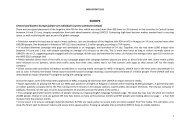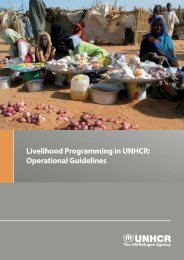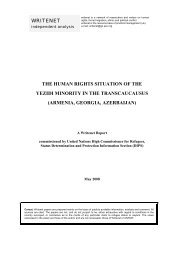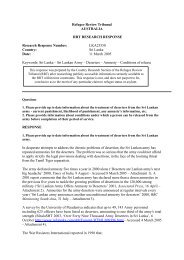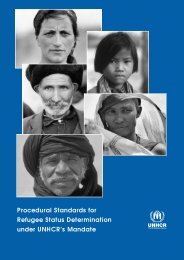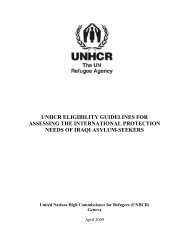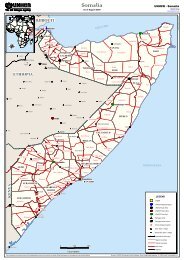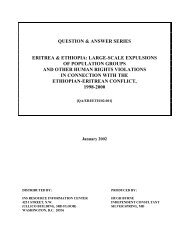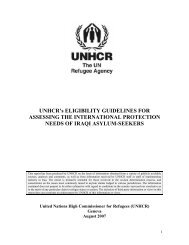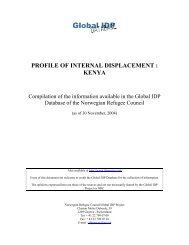CONCLUSIONS ADOPTED BY THE EXECUTIVE ... - UNHCR
CONCLUSIONS ADOPTED BY THE EXECUTIVE ... - UNHCR
CONCLUSIONS ADOPTED BY THE EXECUTIVE ... - UNHCR
You also want an ePaper? Increase the reach of your titles
YUMPU automatically turns print PDFs into web optimized ePapers that Google loves.
2002 (Executive Committee—53 rd Session)<br />
No. 94 (LIII) – CONCLUSION ON <strong>THE</strong> CIVILIAN AND HUMANITARIAN CHARACTER<br />
OF ASYLUM 1 (2002)<br />
The Executive Committee,<br />
Remaining seriously concerned by the continuing occurrence of military or armed attacks and other threats to<br />
the security of refugees, including the infiltration and presence of armed elements in refugee camps and<br />
settlements, 2<br />
Recalling the relevant provisions of international refugee law, international human rights law and<br />
international humanitarian law, Recalling its Conclusion No. 27 (XXXIII) and Conclusion No. 32 (XXXIV) on<br />
military attacks on refugee camps and settlements in Southern Africa and elsewhere; Conclusion No. 72 (XLIV)<br />
on personal security of refugees; Conclusion No. 48 (XXXVIII) on military or armed attacks on refugee camps<br />
and settlements; Conclusion No. 47 (XXXVIII) and Conclusion No. 84 (XLVII), on refugee children and<br />
adolescents, as well as Conclusion No. 64 (XLI) on refugee women and international protection,<br />
Recalling also United Nations Security Council resolution S/RES/1208 (1998) and S/RES/1296 (2000), and<br />
the two reports of the United Nations Secretary-General on the Protection of Civilians in Armed Conflict 3 ,<br />
noting in particular the recommendations made therein with respect to enhancing the security of refugee camps<br />
and settlements,<br />
Welcoming the discussion which took place on the civilian character of asylum in the context of the Global<br />
Consultations on International Protection, 4<br />
Noting that several international meetings have recently been held, aimed at identifying effective operational<br />
strategies for maintaining the civilian and humanitarian character of asylum, 5<br />
Reiterating that refugee camps and settlements should have an exclusively civilian and humanitarian<br />
character, that the grant of asylum is a peaceful and humanitarian act which should not be regarded as unfriendly<br />
by another State, as stated in the 1969 OAU Convention Governing the Specific Aspects of Refugee Problems<br />
in Africa and a number of Executive Committee conclusions, and that all actors, including refugees themselves,<br />
have the obligation to cooperate in ensuring the peaceful and humanitarian character of refugee camps and<br />
settlements,<br />
Recognizing that the presence of armed elements in refugee camps or settlements; recruitment and training<br />
by government armed forces or organized armed groups; the use of such camps, intended to accommodate<br />
refugee populations on purely humanitarian grounds, for the internment of prisoners of war; as well as other<br />
forms of exploitation of refugee situations for the purpose of promoting military objectives are likely to expose<br />
refugees, particularly women and children, to serious physical danger, inhibit the realization of durable<br />
solutions, in particular voluntary repatriation, but also local integration, jeopardize the civilian and humanitarian<br />
character of asylum and may threaten the national security of States, as well as inter-State relations,<br />
Recognizing the special protection needs of refugee children and adolescents who, especially when living in<br />
camps where refugees are mixed with armed elements, are particularly vulnerable to recruitment by government<br />
armed forces or organized armed groups,<br />
Reaffirming the importance of States, <strong>UNHCR</strong> and other relevant actors, integrating safety and security<br />
concerns from the outset of a refugee emergency into refugee camp management in a holistic manner,<br />
(a) Acknowledges that host States have the primary responsibility to ensure the civilian and humanitarian<br />
character of asylum by, inter alia, making all efforts to locate refugee camps and settlements at a reasonable<br />
1<br />
Contained in United Nations General Assembly Document No. 12A (A/57/12/Add.1)<br />
2<br />
For the purpose of this Conclusion, the term "armed elements" is used as a generic term in a refugee context that refers to<br />
combatants as well as civilians carrying weapons. Similarly, for the purpose of this Conclusion, the term "combatants"<br />
covers persons taking active part in hostilities in both international and non-international armed conflict who have entered a<br />
country of asylum.<br />
3<br />
S/1999/957; S/2001/331.<br />
4<br />
EC/GC/01/8/Rev.1.<br />
5<br />
Workshop on the Potential of International Police in Refugee Camp Security (Ottawa, Canada, March 2001); Regional<br />
Symposium on Maintaining the Civilian and Humanitarian Character of Refugee Status, Camps and other locations<br />
(Pretoria, South Africa, February 2001); International Seminar on Exploring the Role of the Military in Refugee Camp<br />
Security (Oxford, UK, July 2001).<br />
147




